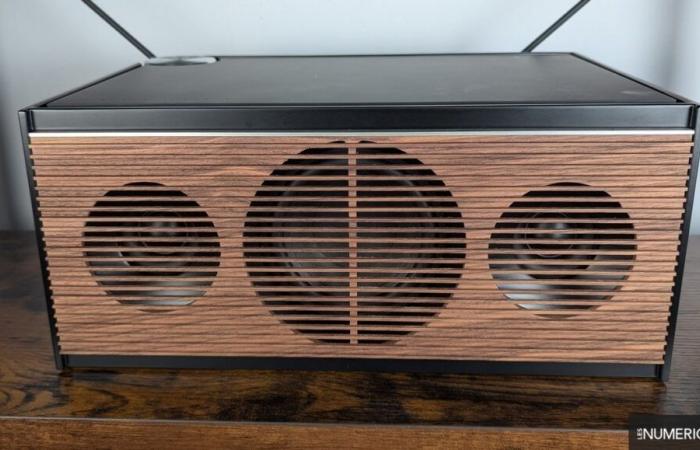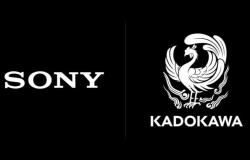Close to what the Authentics 200 and Authentics 500 from JBL deliver in their genre, the PR Link is a sedentary speaker (on mains) which relies on fairly rich wired connectivity and wireless connectivity carried by an external module.
Like other La Boite Concept products, a prominent place is given to design, here openly retro, as well as the quality of the materials used. The device thus displays a cabinetmaker dimension, although wood is relatively in the minority in this case, which brings the device closer to a small piece of furniture or a decorative object. It is thus a continuation of the brand's first speaker adopting this format, the PR/01.
Price & availability
The PR Link Concept Box has been available since the first quarter of 2024 at a price of €1,450. It can be sold with a dedicated powder-coated steel leg for a total price of €1,690 (leg sold alone at €290).
Test Condition
As no dedicated app is associated with the PR Link, the firmware will remain a priori the same for the entire life of the product.
Construction
It is undeniable that the PR Link stands out from the rest, despite a fairly measured use of noble materials. Unlike many of the manufacturer's products, it is not the wood that has the pride of place, but the bakelite which constitutes the bulk of the chassis. This antediluvian polymer, very robust, has a high density and delivers a good feeling of rigidity to the whole, all without appearing cheap. Not completely in one piece, the PR Link is topped with a removable magnetic plate giving access to the different entrances.
As for the finishes, nothing to say. The Concept Box has a very beautiful protective grille in walnut, which accentuates the retro side, grille glued to a brushed aluminum strip on which the different accessible entrances are engraved. Last little touch, the presence of an imposing aluminum multifunction wheel on the rear left corner.
Quite compact (360 x 160 x 250 mm) and made rather discreet by the presence of a laminar cable duct at the rear, the PR Link relies on a refined design which is above all a tribute to the antique speakers of the French manufacturer Siare — its founder Marie Yemarian Cagniard is also the grandmother of the founder of La Boite Concept.

Wireless connectivity & broadcasting
Without being a real sound hub, the PR Link is aimed at almost all users. Discreetly placed in the cavity sheltered by the plate, the wired sockets cover the analog genre and the digital genre: an HDMI eARC input, a Toslink optical socket, an RCA line input and a 3.5 mm jack line input. Added to this are two USB ports (one USB-A and one USB-C), unfortunately only dedicated to charging. In fact, the speaker can be used in almost all situations.
Concerning connectivity, things are a bit more complex, because the PR Link does not directly integrate this technology. In order to ensure this function, the manufacturer has chosen an external Bluetooth/wifi module, the Escape M1 Air, here integrated and powered via a custom-made notch, and a small adapter with input micro-USB and optical (outputs used by the module).
Via this module, the PR Link gains AirPlay 2, Chromecast, Spotify Connect, Room Ready, and even Bluetooth compatibility (latency of 280 ms).

User experience
Orders
A pure model, the PR Link is not particularly rich in terms of settings. While the lack of a remote control is not surprising, we would have at least liked a complete interface.
Here, everything is based on the large multifunction aluminum wheel, which simultaneously selects the input (short press), adjusts the volume, turns it on/off and switches between two sound modes for the bass (presses of 3 s). Only a small button dedicated to Bluetooth pairing is associated with the wheel. Everything is accompanied by a small row of white LEDs, all associated with a specific input. So the speaker misses the navigation, which somewhat hampers the experience.
Application
Going once again to the simplest, La Boite Concept does not bother with a dedicated application. The manufacturer, via the Escape module, relies on the use of the Google Home ecosystem (the only simple way to connect the device to the network on Android) or the AirPlay 2 protocol. All possible adjustments and settings go through there . Obviously, the user experience is Spartan, if not minimalist. This is especially true as the device is not recognized as PR Link, but Escape M1 Air (module name). An Escape application does exist, but it is distinguished by its instability and does not provide any adjustments.

Audio
A specialty of the manufacturer, the audio architecture is very surprising. Featuring a stereo layout with frontal sound diffusion, La Boite Concept PR Link integrates two 19 mm dome tweeters and an Active Pressure Reflex system placed in the center. The latter comes in the form of a 11.5 cm bass/midrange speaker placed on the front, connected by an aluminum tube to a 11.5 cm woofer placed recessed.
This structure, associated with a laminar bass reflex placed at the rear, acts like a piston to increase the bass level. For amplification, the manufacturer uses a circuit from Micromega (company acquired in 2021), composed of two class D amplifiers for the woofers, and two class AB amplifiers for the tweeters. All this achieves a power (measured at 1% distortion) of 140 W RMS.
The very strange “double speaker” system integrated here
© La Boite Concept
Due to its fairly compact format, it is difficult to expect miracles regarding bass quality. On this, we are unfortunately not entitled to an excellent surprise, since if the resistance in the low end of the spectrum is good, being able to hit 50 Hz without too much difficulty, or even less, the speaker does not display a mastery ideal. The sound is very powerful in this register, but this characteristic is accompanied by a distortion that is quickly audible when increasing the decibels. On some of our test tracks, the PR Link simply seems in difficulty, prey to excesses, as if La Boite Concept had set the bar a little too high. Note that there are two sound modes: Standard Bass, and Less Bass. It is the latter, the more reasonable and balanced of the two, that we choose almost systematically (mode used to measure).
The fact remains that when leaving very low frequencies, these humming effects and these overflows fade away quite quickly. The low-mids are quite punchy and controlled, especially since this register, as well as all the mids, shines with its balance. Not to mention the sound slap, the rendering is rich in this frequency range, driven by a good level of detail and good dynamics.
For the treble, the speaker opts for the same character as the mids, that is to say an almost optimal balance, only marked by a few barely audible oscillations. Apart from the overflows in the bass, the PR Link stands out for its natural rendering, neither aggressive nor soft, which opens the doors to the vast majority of musical styles. We must still add a new downside, since the treble is not free from inaccuracies (from 6 kHz). These are barely audible at moderate volume, but increase when pushing the knob. This concern is less than on the Prodige speaker from A.absolument, but clearly remains an area of improvement for the manufacturer. Very demanding pieces can quickly lack finesse.
Quite surprisingly, the soundstage is much less cramped than we might have thought. The stereo representation is certainly much less marked than on a real pair of speakers, but it is not ridiculous. The through effects are honestly rendered and a certain depth is established, all with a fairly broad directivity. Above all, the PR Link distills a good level of detail and good general dynamics.
Last small flaw/detail, the sound level of the product is never associated with the volume of the protocol or the OS. You must therefore adjust the volume on the speaker side, and on the smartphone/tablet side.







